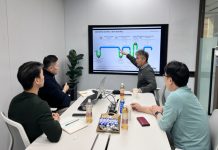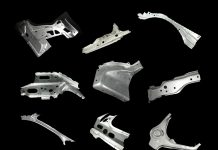Dr. Dimitris Servis: AutoForm Project Manager Talks the Digital Factory & Industry 4.0
Today we are well into the deployment of Industry 4.0 principles in all manufacturing activities. It is without doubt that this is not a marketing fad: unlike other initiatives in the past, there has been a fertile environment for Industry 4.0 to flourish.
 Firstly there is an actual need. Decentralized and distributed manufacturing, value chains consisting of disparate corporate structures, human and machine systems and subsystems, significant investment in generating information (aka knowledge) and neglect it in information silos. There’s an imminent need to integrate these separate systems and allow them to interoperate seamlessly. This means make information flows and interfaces talk to each other.
Firstly there is an actual need. Decentralized and distributed manufacturing, value chains consisting of disparate corporate structures, human and machine systems and subsystems, significant investment in generating information (aka knowledge) and neglect it in information silos. There’s an imminent need to integrate these separate systems and allow them to interoperate seamlessly. This means make information flows and interfaces talk to each other.
Second, the technology required is there. Unlike previous efforts today it is clear that the computing power and the way the computing world transforms, provides the required technology layer to meet these requirements. From cloud applications, to the Industrial Internet, previously separated physical and virtual sources and sinks of information are now connected on a global scale.
Immersive environments and additive manufacturing allow humans to integrate organically into agile prototyping and production. The infrastructure to process the immense amount of data and extract useful intelligence from it is on hand. Cybersecurity, although still an issue, is advancing. Simulation is critical to provide the virtual prototypes and insight into the various processes.
Thirdly, from a business perspective, it is now understood that investments in these technologies, in the mid run, are offset by eliminating the waste of inefficient processes. But cost efficiency is not the only business driver. Industry 4.0 will bring new ways of developing, manufacturing and delivering products to customers and will do that in increasingly narrower segments. Having more control over the processes, it means that quality can be dramatically improved, as well as customer satisfaction from goods and services, improved warranty claims, and new delivery business models. So in a nutshell, the three elements of innovation are there for Industry 4.0: it is desirable, business viable and technically feasible.
If we build it will they come? The tryout reality check
The devil is in the details. The change management to implement these changes involves the human factor and whether all stakeholders subscribe to this vision. In addition to that, and although from the bird’s eye view everything is bright, focusing on specific processes shows that there are a lot of obstacles to overcome. Tryout is a good case to demonstrate these issues. This is the process where a set of metal forming tools, with focus on the deep drawing operation, is tested and prepared for production. As soon as the tool and process design are done, the tool geometries are sent for milling and the manufactured tools are sent along with the tryout package to the specialists that prepare the actual tools and processes for production. The design of the tools and process is by and large done today through simulation. AutoForm provides a virtualized set of apps to do that and goes the extra (long) mile with AutoForm-Sigma to allow the simulation of the production process rather than that of a single product. But at the end of the day it is up to the specialists in tryout to decide and modify based on their extensive and invaluable experience the tools and processes before going to production. This is a process that is hard to codify and automate as it depends on the experience and mental models of the individuals in the factory. These people let all of us have cars, produced to high quality standards. At the same time the tryout transforms the metal forming process in a way that it may be incompatible with the engineering intent. To date this is acceptable. However if one wants continuity and control of the entire value chain, the tryout could be the critical step where this is lost.
There are several reasons why this incompatibility exists. One of the main issues is the opaque, intermittent or non-existent data exchange between functions. The three key information producers and consumers, the product and process design, the tool manufacturing and the tryout, transform information often with adverse effects and without feedback.
First off, the quality of the primary information coming out of designers is often questionable. Issues are not thoroughly explored or resolved and difficult cases are left to the tryout to figure out the workarounds. Although this shows the capabilities of the tryout in troubleshooting it also shows that trouble exists and it is just propagated downstream. Second, the three parties have standards that are incompatible. Take the critical case of beads: what is designed, milled and delivered can be three different things. These modifications are not registered. Third, there is little feedback, communication and collaboration in order to continuously improve the process and perform better next time.
Of course this is not necessarily the case everywhere and in many cases there are excellent and transparent processes. However, add an internal or external supplier that does not perform at that level to the system, and the whole system is suddenly constrained. Furthermore the way the tools are modified is done on a mental model that is validated against the pragmatic results of the tryout but not against the engineering intent or the production performance. Given the pressure in most tryout departments there’s usually little time and space to experiment with decisions. These are taken quickly, based on practices that work and past experience, to get the tools to buy-off. Looking at the big picture, industry pundits would agree that the three major functions operate with little or distorted engagement. So here’s a process that is inherently human-based and difficult to automate. Or is it?
Make way for AutoForm-TryoutAssistant
AutoForm is no stranger to innovation, agility and bold undertakings. It is no surprise that AutoForm is the first company to dare to measure its simulation products to the highly nonlinear and non-robust reality. This is by no means trivial. The major premise is that simulations done in engineering contain a wealth of information that is untapped by tryout. Making this information available in a way that assists the tryout to make decisions aligned with the engineering intent, and record all decisions so that these can be reviewed and re-simulated – bridges engineering, tryout and production.

But the prepared simulation needs to be of high quality and aligned with the tryout practices. In the same way that one good part in tryout though does not mean the tryout is done, one “green” simulation in engineering is not enough to wrap up the process.
AutoForm-Sigma is required to generate the wealth of information that characterizes not the single product but the entire process. This is a simulation of the tryout process itself, a big part of its digital twin, what in essence Industry 4.0 is calling for. It incorporates the tryout standards and practices, the tolerances at which beads are milled, the binder forces that are needed and so on. This is in contrast with a simulation that looks good in engineering but is detached from the reality of the factory. AutoForm-TryoutAssistant uses models built on top of this simulation to provide tryout specialists with clear information for their decision making. It goes further to help them align with the engineering intent by using the draw-in metric as the centerpiece of performance. AutoForm-TryoutAssistant clearly communicates the engineering intent to stakeholders, helps them align with it and register all the discrepancies, issues and changes for further review and action. It is both an invaluable communication and data crunching application, on a tablet, in the hands of specialists, next to the tryout press.
As with all models it is practically impossible to incorporate all variables into the system, not least because some variables are unknown. However, experience with simulations of this kind shows that even in the cases where there are notable differences in absolute values, gradients and deltas are more than good enough to drive the process. AutoForm-TryoutAssistant incorporates this philosophy and its power has already been demonstrated. But AutoForm is restless regarding the improvement of its models and apps. As AutoForm-TryoutAssistant integrates into customer processes, AutoForm uses these experiences to improve all the products that are involved and help users to prepare better simulations and better tryouts.
In Closing
When seeking to understand if a tool, app or process is worthwhile, I try to envision how this will be done in ten years from now. When I think of the tryout, I imagine that much of the work will be automated in ‘the AutoForm-TryoutAssistant way.’ Tryout specialists will be more concerned with devising the new practical methods to address the new processes, tools and materials that will come and make it into the new products. They will have to assist engineers to codify these into simulations, a process that generates more and more software tools upstream. So despite the difficulties, the effort is well worth it.













